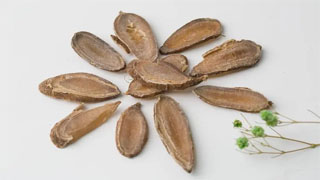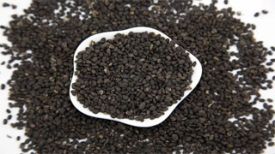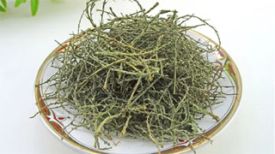
1. Alias
E Qin, Gui Yu Jin, Mao E Shu, Huang Si Yu Jin, Lv Si Yu Jin.
2. Plant morphology
Yujin: The plant is 0.8-1.6 meters tall, with a light yellow root and stem section and a light white outer skin. Thick and oval in shape. The root has a spindle shaped tuberous root. The petiole is about 30 centimeters long, the leaf blade is green, oblong or ovate oblong, 35-75 centimeters long and 14-22 centimeters wide, both sides are hairless, the base is nearly circular or broadly wedge-shaped, and the tip is gradually pointed and has a short tail shape. The spike shaped inflorescence first leaves out at the root and stem, measuring 20-30 centimeters in length. The crown bracts are light red and elongated, measuring 5-8 centimeters in length. The apex is sharp and pointed, while the middle and lower bracts are green and ovate, measuring 3-5 centimeters in length. The sepals are white and 1-1.2 centimeters in length. The corolla is white, the corolla tube is about 28 centimeters long, and there are white soft hairs at the throat. The corolla lobes are about 1.5 centimeters long and 1.2 centimeters wide. The lateral stamens are yellow, petal shaped, oblong, about 1.7 centimeters long. The lip is folded, yellow, and the middle is brownish yellow. It is inverted oval, about 22 centimeters long, and the tip is slightly concave. The filaments are short, the base of the anthers is 2-spaced, and the ovary is densely hairy. The flowering period is from May to June.
Turmeric: a perennial herb, about 1 meter tall. The rhizome has multiple branches. It is orange yellow to yellow in color, cylindrical in shape, and has spindle shaped tubers at the root tips. The petiole is 20-45 cm long, the leaf blade is green, oblong or elliptical, 30-45 (~90) cm long, 15-18 cm wide, and hairless on both sides. The base is narrow, extending downwards to the petiole, and the tip gradually becomes pointed. The spike shaped inflorescence is extracted from the center of the leaf sheath, cylindrical, 12-18 cm long, 4-9 cm wide, with gray green bracts in the middle and lower parts, ovate to oblong, 3-5 cm long. The tip is blunt and round, with the crown bracts spreading out. It is white or green, sometimes light reddish purple, and the tip is acute and pointed. The sepals are white, measuring 0.8-1.2 centimeters in length, covered in soft hairs, with a three toothed tip. The corolla is light yellow, and the corolla tube is up to 3 centimeters long; The corolla lobes are triangular in shape, measuring 1-1.5 centimeters in length, with one larger fragment above and a pointed tip. The lateral degenerated stamen is shorter than the lip. Lips yellow, brownish yellow in the middle, inverted oval, 1.2-2 cm long. The base of the anthers has a distance; The ovary has soft hairs. The flowering period is in August.
Guangxi Curcuma: a perennial herb. The tuberous root is spindle shaped with a white cross-section. Leaf basal, 2-5 leaves, two rows, short petiole; Leaves elliptical lanceolate or elongated elliptical. The spike shaped inflorescence is extracted from the rhizome or from the center of the leaf sheath, and the inflorescence is cylindrical; Peanuts are located in the axils of the lower and middle bracts; Calyx white, corolla lobes 3, ovate lateral degenerated stamens oblong; Lips nearly circular, light yellow; The filaments are flattened and wide, and the anthers are narrow and round; The ovary is covered with long soft hairs, the style is filamentous, the stigma is head shaped, and has ciliated hairs. The flowering period is from May to July.
Pongzhuo: The plant is about 1 meter tall. The root and stem sections are light blue, light green, light yellow green, or yellow. The root has a spindle shaped tuberous root. Leaf sheath dark brown; The petiole is longer than the leaf blade, and there are purple bands along the green midrib on both sides of the leaf blade. It is oblong lanceolate, 25-60 cm long and 10-15 cm wide, with no hairs on the upper surface and sparse hairs on the back. The spike shaped inflorescence is extracted from the rhizome, measuring 10-18 centimeters in length and 5-8 centimeters in width. The bracts in the middle and lower parts are light green, with a purple red tip and a broad lanceolate shape. The tip is gradually or sharply pointed, and the bracts in the crown are white and the tip is dark red. The corolla tube is white, about 3 centimeters long, and the corolla lobes are red, about 1.5 centimeters long. The lateral degenerated stamens are petal shaped, with lips that are nearly inverted oval in shape, yellow in color, and a deep yellow center. The middle lobes have concave tips, and the ovary is hairy.
3. Origin distribution
Distributed in Guangxi, Yunnan, Sichuan and other places.
4. Harvesting and processing
After the stems and leaves wither in winter, they should be harvested, steamed or boiled until they are fully penetrated, and then dried.
5. Characteristics of medicinal herbs
Wen Yu Jin: It is oblong or oval in shape, slightly flattened, some slightly curved, with gradually pointed ends, measuring 3.5-7 centimeters in length and 1.2-2.5 centimeters in diameter. The surface is gray brown or gray brown, with irregular longitudinal wrinkles, and the color of the raised longitudinal lines is lighter. Solid texture, gray brown cross-section, keratinous appearance; The inner layer ring is obvious. The aroma is slightly fragrant, and the taste is slightly bitter.
Turmeric (Huangsi Yujin): It is spindle shaped, with some ends being slender, measuring 2.5-4.5 centimeters in length and 1-1.5 centimeters in diameter. The surface is brownish gray or grayish yellow, with fine wrinkles. The cross-section is orange yellow, and the periphery is brownish yellow to brownish red. It has a fragrant aroma and a spicy taste.
Guangxi Curcuma (Cinnamomum cassia): elongated cone-shaped or elongated. The surface is light brownish yellow with fine longitudinal wrinkles. Solid in texture, with a light grayish brown cross-section, granular or keratinous in shape, and a distinct inner layer ring. The air is faint and the taste is light.
Pongzhu (Green Silk Curcuma): It is long oval shaped, thick and robust, measuring 1.5-3.5 centimeters in length and 1-1.2 centimeters in diameter. The air is faint and the taste is light.
6. Sexual Taste Returning to the Classics
Cold in nature, pungent and bitter in taste. Return to the liver meridian, heart meridian, and lung meridian.
7. Effect and Function
Promote blood circulation and relieve pain, promote qi stagnation, clear the heart and relieve depression, promote bile flow and eliminate jaundice. A blood activating painkiller classified under the category of blood activating and stasis removing drugs.
8. Clinical application
Dosage: 3-9 grams, decoct and take, used to treat menstrual cramps, fever, dizziness, epilepsy, jaundice, hematuria, chest and abdominal distension, and stabbing pain.
9. Pharmacological research
Enhance immune function, have central nervous system inhibitory effect, have protective effect against myocardial injury, anti liver injury, anti pregnancy effect, and increase spleen cAMP content; The water-soluble part has significant therapeutic effects on experimental arrhythmia in mice, and its water extract (1:3) has inhibitory effects on various skin fungi in vitro.
10. Chemical composition
There are volatile oils, mainly containing linalool, camphor, eugenol, curcumin, carotenoids, etc.
11. Usage taboos
Those with yin deficiency, blood loss, and no qi stagnation and blood stasis are prohibited from taking it, and pregnant women should take it with caution. Not suitable for use with cloves or mother cloves.
12. Compatibility prescription
① Treatment for women with rib distension caused by qi reversal: Yujin, Muxiang, Curcuma, Peony Skin. Grind white soup for consumption. ("Compendium of Materia Medica" cites "Essential Prescriptions for Women's Health")
② Treating itching, sores, swelling, and pain: Apply Yu Jin powder with water and it will disappear immediately. (The Compendium cites the Summary of Medical Formulas)
③ Treating bleeding and vomiting: Take 6 grams of Yujin powder orally. Even more so, I'll take it again. (Simplified Formula Theory)
④ Treating vomiting blood: 30g of Yujin (file) and 30g of Licorice (roasted) each. Add two flavors and mash them into powder. Take 6 grams per dose, adjust to Jinghua water at any time. (Yu Jinsan from the "General Record of St. Ji")
⑤ Treatment of hematuria: 30g of turmeric, crushed into powder, mixed with scallions, boiled three times in one cup of water, and removed from the residue. Warm clothing is required three times a day. (The Compendium cites the Empirical Formula)
⊙ The content of the article is for clinical reference only. Non TCM professionals are not allowed to test drugs.


